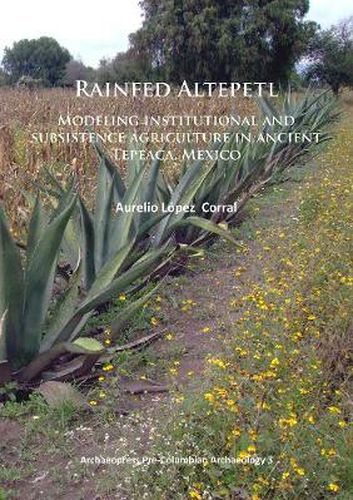Readings Newsletter
Become a Readings Member to make your shopping experience even easier.
Sign in or sign up for free!
You’re not far away from qualifying for FREE standard shipping within Australia
You’ve qualified for FREE standard shipping within Australia
The cart is loading…






Climate variability and human management strategies on crop stands were major factors that frequently affected agricultural yields among indigenous populations from central Mexico. This work seeks to model food production in ancient Tepeaca, a Late Postclassic (AD 1325-1521) and Early Colonial (16th century) state level-polity settled on the central highlands of Puebla, by applying a model that recognizes the presence of two independent and interconnected forms of food production: subsistence agriculture and institutional agriculture. Crop stands within this region depended heavily on rainfed conditions, a form of agriculture that often generates unstable interannual fluctuations in yields. Archaeology acknowledges the effects of such variations on the economy of households and institutions, but attention has been largely put on estimating average productivity values over long periods rather than focusing on interannual divergences. Such instability of agricultural production was recorded among modern Tepeaca’s agriculturalists through an ethnographic survey. This crucial information, along with archaeological data and local 16th century historical sources, is used for modeling the effects of climate variability among prehispanic populations and serves to better comprehend the organization of past agrarian structures, tribute systems and land tenure organization at the household and regional levels.
$9.00 standard shipping within Australia
FREE standard shipping within Australia for orders over $100.00
Express & International shipping calculated at checkout
Climate variability and human management strategies on crop stands were major factors that frequently affected agricultural yields among indigenous populations from central Mexico. This work seeks to model food production in ancient Tepeaca, a Late Postclassic (AD 1325-1521) and Early Colonial (16th century) state level-polity settled on the central highlands of Puebla, by applying a model that recognizes the presence of two independent and interconnected forms of food production: subsistence agriculture and institutional agriculture. Crop stands within this region depended heavily on rainfed conditions, a form of agriculture that often generates unstable interannual fluctuations in yields. Archaeology acknowledges the effects of such variations on the economy of households and institutions, but attention has been largely put on estimating average productivity values over long periods rather than focusing on interannual divergences. Such instability of agricultural production was recorded among modern Tepeaca’s agriculturalists through an ethnographic survey. This crucial information, along with archaeological data and local 16th century historical sources, is used for modeling the effects of climate variability among prehispanic populations and serves to better comprehend the organization of past agrarian structures, tribute systems and land tenure organization at the household and regional levels.